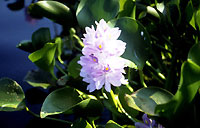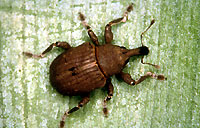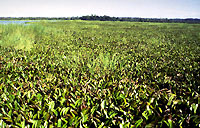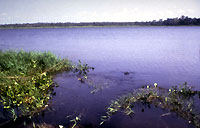| Entomology Home |

an overview
of biological control research in CSIRO Entomology
| Biological Control Home | ||
|
|
||
| Aquatic Weeds » | ||
|
|
||
|
|
||
| Biopesticides | ||
| Entomology Home | ||
| Biological Control Home > Classical biocontrol > Environmental weeds |
Water hyacinth, Eichhornia crassipes
The control of water hyacinth in many countries around the world is a spectacular example of successful biocontrol. Water hyacinth, a native of the upper Amazon catchment, is one of the world's worst aquatic weeds and was probably imported as an aquarium plant. It is first recorded in Australia in the 1890s. Once in rivers, dams and lakes, it can double its size within a few weeks, forming mats which impede the use and ecology of the waterways. Several biocontrol agents were released in Australia in the 1970s and 1980s, building on the initial research done in the USA. The tunnelling larvae of these insects achieved good control in impoundments in sub tropical and tropical eastern Australia. But it is overseas where CSIRO's expertise has had the most spectacular results. Most control has been achieved by two weevils, Neochetina bruchi and N. eichhorniae. Massive infestations in the Sepik River lagoons (Papua New Guinea), were cleared in less than five years. Similarly, in collaboration with a range of organisations, huge infestations in Lake Victoria (Kenya, Uganda and Tanzania) were cleared of water hyacinth in less than three years. The technology has also been used by others with dramatic effects in Benin (West Africa), South Africa and Thailand. Supported by: Australian Centre for International Agricultural Research (ACIAR), AusAID
|




